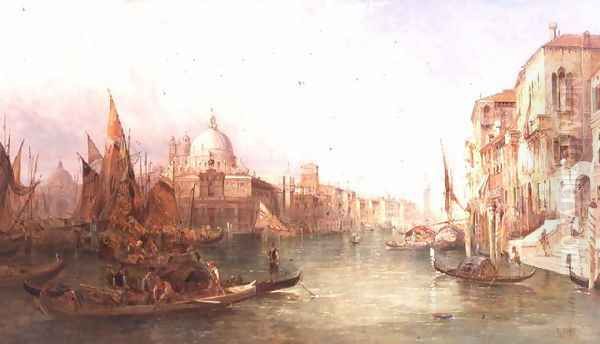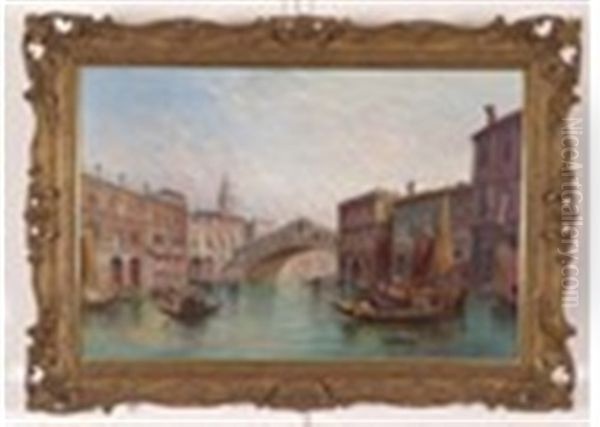Alfred Pollentine stands as a notable figure among the British artists of the Victorian era, celebrated primarily for his evocative and atmospheric depictions of Venice. Active during the latter half of the 19th century, Pollentine dedicated much of his career to capturing the unique light, architecture, and daily life of the Italian lagoon city. His work, often characterized by a warm palette and a somewhat Impressionistic handling of paint, found favour with audiences who appreciated the romantic allure of Venice, a subject that held considerable fascination for British travellers and art collectors of the period. While Venice was his most recurrent theme, he also turned his brush to scenes within his native Britain.
Early Life and Artistic Formation
Born in Britain in 1836, Alfred Pollentine emerged as an artist during a vibrant period in British art. Details surrounding his formal artistic training remain somewhat scarce in historical records. Unlike many contemporaries who might have left clearer trails through the Royal Academy Schools or documented apprenticeships, Pollentine's path to becoming a professional painter is less defined. It is plausible he received informal instruction or was largely self-taught, honing his skills through observation and practice, a route not uncommon for artists outside the main academic structures of the time.
His artistic career appears to have gained momentum from the 1860s onwards. He began exhibiting his works at various London venues, which was crucial for establishing a reputation and securing patronage. These exhibitions would have placed his work before the eyes of critics, fellow artists, and the buying public. While specific mentors are not definitively linked to him, he would undoubtedly have been aware of the prevailing artistic trends, including the enduring legacy of British landscape painting and the burgeoning interest in more modern, continental styles like Impressionism.
The Enduring Fascination with Venice

Venice held a powerful grip on the European artistic imagination long before Pollentine's time, and its popularity surged during the 19th century. The city's unique blend of decaying grandeur, shimmering waterways, distinctive architecture, and vibrant street life offered endless inspiration. Artists were drawn to its unparalleled light effects, the reflections on the canals, and the romantic associations fostered by centuries of history and literature. For British artists and audiences, Venice was often encountered through the tradition of the Grand Tour, solidifying its status as a place of cultural pilgrimage and artistic challenge.
Pollentine immersed himself in this subject, making it the cornerstone of his oeuvre. He followed in the footsteps of giants who had famously depicted the city, such as the 18th-century Venetian masters Canaletto and Francesco Guardi, known for their detailed topographical views (vedute). However, Pollentine’s approach differed, aligning more closely with later artists who sought to capture atmosphere and mood over precise architectural rendering. He shared this fascination with Venice with numerous contemporaries, including the great British watercolourist J.M.W. Turner, whose late Venetian works dissolved form into light and colour, and later figures like James Abbott McNeill Whistler, Walter Sickert, and the American expatriate John Singer Sargent, each bringing their own modern sensibilities to the ancient city. The French painter Félix Ziem also dedicated a significant portion of his work to luminous Venetian scenes.
Pollentine’s Venice is often bustling yet dreamlike. He frequently depicted iconic locations such as the Grand Canal, the Dogana da Mar (Customs House) at the entrance to the canal, the magnificent baroque church of Santa Maria della Salute, and views incorporating St Mark's Square and the Doge's Palace. His canvases are typically populated with gondolas gliding on the water, figures strolling along the Riva degli Schiavoni, and the interplay of sunlight and shadow on weathered facades. Works like The Grand Canal Venice, Santa Maria Della Salute And View Of San Marco, and Dogana, Venice are representative of his focus, showcasing his ability to combine recognisable landmarks with a sense of lived experience.
Artistic Style and Technique
Alfred Pollentine's style is often described as leaning towards Impressionism, though perhaps more accurately placed within the broader context of atmospheric landscape painting popular in Britain during the Victorian era. He employed looser brushwork than the highly finished academic style, allowing for a sense of immediacy and movement, particularly in his rendering of water and skies. This technique aligns with the Impressionist interest in capturing fleeting moments and the effects of light, although his work generally retains a stronger sense of structure and traditional composition than that of core French Impressionists like Claude Monet or Camille Pissarro.

A key characteristic of Pollentine's art is its warmth. He favoured a rich and often luminous colour palette, using golds, pinks, warm blues, and creamy whites to convey the unique quality of Venetian light, especially during sunrise or sunset. His scenes often possess a romantic, slightly hazy quality, blending realism with an idealized vision of the city. This approach successfully combined topographical interest – viewers could recognize the famous sites – with an emotional resonance, evoking the feeling of being in Venice.
He skillfully captured the reflections on the water, a defining feature of the Venetian landscape. The interplay between the solid forms of the buildings and their shimmering, distorted images on the canals is a recurring motif. His application of paint could be quite dynamic, building up textures to represent stone, water, and the activity of figures and boats, giving his canvases a lively surface. This contrasts with the smoother, more detailed finish of earlier veduta painters but shares an affinity with the painterly approach seen in some contemporary landscape artists.
Beyond Venice: British Landscapes
While Venice dominated his output and forms the basis of his reputation, Alfred Pollentine did not exclusively paint Italian scenes. He also turned his attention to the landscapes and coastal views of his native Britain. Evidence of this includes paintings depicting locations such as Whitby, a historic fishing town on the Yorkshire coast known for its dramatic cliffs and harbour. This subject matter was popular among British artists, tapping into a national appreciation for maritime scenery and picturesque coastal towns.
Painting British scenes allowed Pollentine to explore different light conditions and landscapes compared to Venice. The cooler, often more turbulent atmosphere of the North Sea coast offered a contrast to the sun-drenched Adriatic lagoon. Artists like Clarkson Stanfield were renowned for their British marine paintings, and the American painter Winslow Homer captured the ruggedness of the coast, albeit with a different stylistic focus. Pollentine's British works demonstrate his versatility as a landscape painter, although they remain less numerous and less celebrated than his Venetian views.
His engagement with British subjects indicates an artist grounded in his own national traditions of landscape painting, even while pursuing his passion for a specific foreign locale. These works provide a broader context for understanding his artistic interests and capabilities beyond the canals of Venice.
Exhibitions, Recognition, and the Art Market

Throughout his active years, roughly spanning from the 1860s to the 1880s, Alfred Pollentine sought recognition through regular exhibitions. He is known to have shown his work at prominent London venues such as the Royal Society of British Artists (Suffolk Street), a significant alternative exhibition space to the Royal Academy, and the British Institution. Exhibiting at these galleries was essential for building a career, attracting patrons, and engaging with the contemporary art scene. The provided information also notes that his work was exhibited in France, suggesting an effort to reach an international audience, further enhancing his reputation.
Pollentine achieved a degree of commercial success during his lifetime and his works continue to be traded on the art market today. Auction records provide glimpses into the value placed on his paintings. For instance, a Venetian scene like The Grand Canal Venice was estimated or sold for figures in the range of €6000-€7000, while a British subject, an oil painting of Whitby, fetched £850. These prices indicate a consistent collector interest, positioning him as a competent and popular artist within his specific niche, even if not reaching the stratospheric prices of the era's biggest names.
His appeal likely stemmed from his ability to produce attractive, well-executed paintings of a highly desirable subject. For Victorian collectors, a Pollentine view of Venice offered a tangible connection to the romance and beauty of the city, rendered in a style that was accessible and aesthetically pleasing, balancing traditional representation with a touch of modern atmospheric sensibility.
Context: Victorian Art and the Venetian Obsession
Alfred Pollentine worked during the Victorian era, a period of significant change and diversity in British art. The Royal Academy remained a powerful institution, but alternative movements and exhibition societies flourished. Landscape painting was immensely popular, building on the legacies of John Constable and J.M.W. Turner. There was also a growing awareness of, and sometimes resistance to, continental European trends, particularly French Realism and Impressionism.
The influence of the critic and writer John Ruskin was pervasive, especially his passionate advocacy for Turner and his detailed analyses of Venetian architecture and art in works like "The Stones of Venice." Ruskin's writings undoubtedly fuelled the British fascination with the city, encouraging artists and travellers to look closely at its history, beauty, and state of decay. Pollentine’s work, focusing on the picturesque and atmospheric aspects of Venice, resonated with this cultural climate.

His contemporaries included artists exploring various styles. While the Pre-Raphaelites focused on detailed realism and literary themes, other artists pursued landscape and genre painting. Figures like John Atkinson Grimshaw became known for their evocative moonlit urban and dockside scenes, sharing Pollentine's interest in atmosphere, though with a distinctly different mood and palette. Pollentine’s particular brand of Venetian painting offered a sunny, romantic counterpoint to the often more sombre or industrial scenes depicted by some other British artists of the time.
Legacy and Conclusion
Alfred Pollentine passed away in 1890. He left behind a substantial body of work, primarily dedicated to celebrating the visual splendours of Venice. While perhaps not considered a major innovator who drastically altered the course of art history, he was a highly skilled and successful painter who excelled within his chosen speciality. His contribution lies in his consistent and recognizable depictions of Venice, rendered with a characteristic warmth, atmospheric sensitivity, and a gentle nod towards Impressionistic techniques.
His paintings satisfied a significant demand in the Victorian art market for romantic and picturesque views of Italy's most famous lagoon city. He captured the interplay of light, water, and architecture with a deft touch, creating images that continue to appeal to collectors for their beauty and evocative power. He stands as a significant practitioner of Venetian view painting in the later 19th century, effectively translating the enduring allure of the city for a British audience.
In the grand narrative of art history, Alfred Pollentine occupies a specific niche, distinct from the groundbreaking experiments of the French Impressionists or the narrative complexities of some of his British contemporaries. Yet, his dedication to capturing the soul of Venice, with its unique blend of grandeur and intimacy, light and shadow, ensures his place as a noteworthy artist of his time, whose works remain a testament to the enduring artistic fascination with La Serenissima.